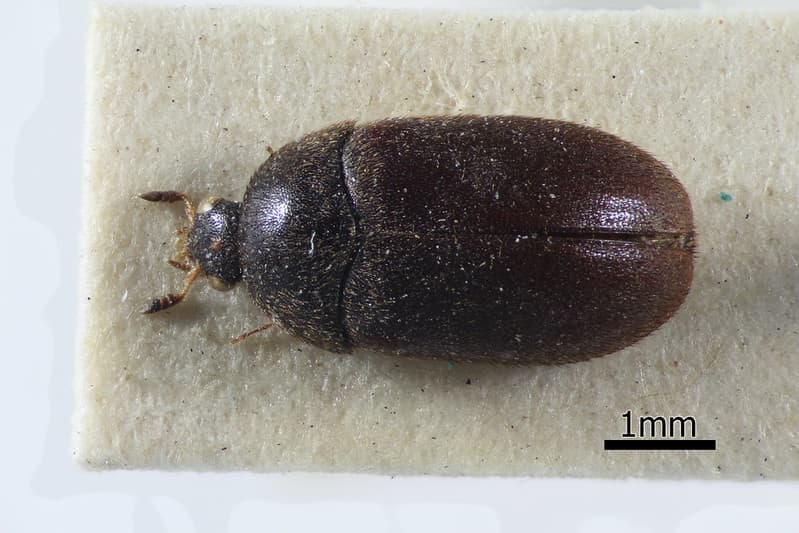
Black and Brown Carpet Beetle
For many people, there’s some confusion about Black Carpet Beetles and brown ones.
While there are several types of carpet beetle, the Black Carpet Beetle is the most common. These beetles can be white, brown, or black, depending on how old the adults are.
When the larvae pupate, the adults emerge white. After that, they will gradually darken as they age, till they’re the standard black color.
If you see a brown carpet beetle, the chances are that it’s just a young black carpet beetle.
Black Carpet Beetle Bites
People often wrongly think that they have Black Carpet Beetle bites.
These pests don’t consider you a valuable food source. They’re scavengers, and they may eat the hair you’ve shed, but carpet beetles DO NOT bite people.
The main reason for this misconception is that some people get a rash when carpet beetles move into their carpet, rugs, or bedding.
The larvae of these beetles have a covering of brown hair. Many people are allergic to the larva’s shed skins and the brown hair on those skins.
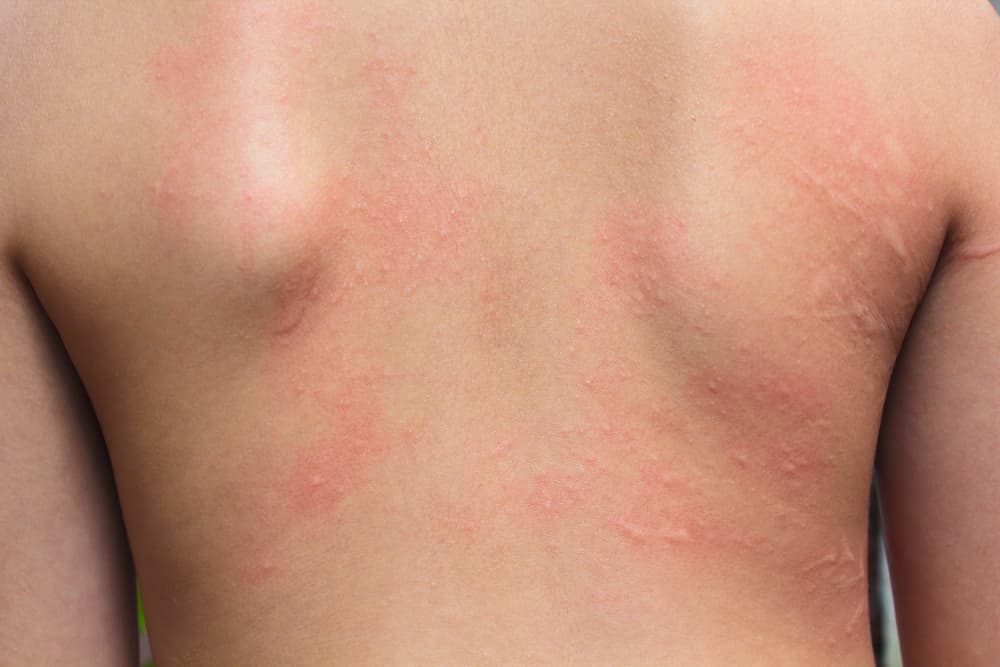
- Red eyes (they may itch or water)
- A rash
- Itchy skin
- Hives
- Tummy problems
- A runny nose
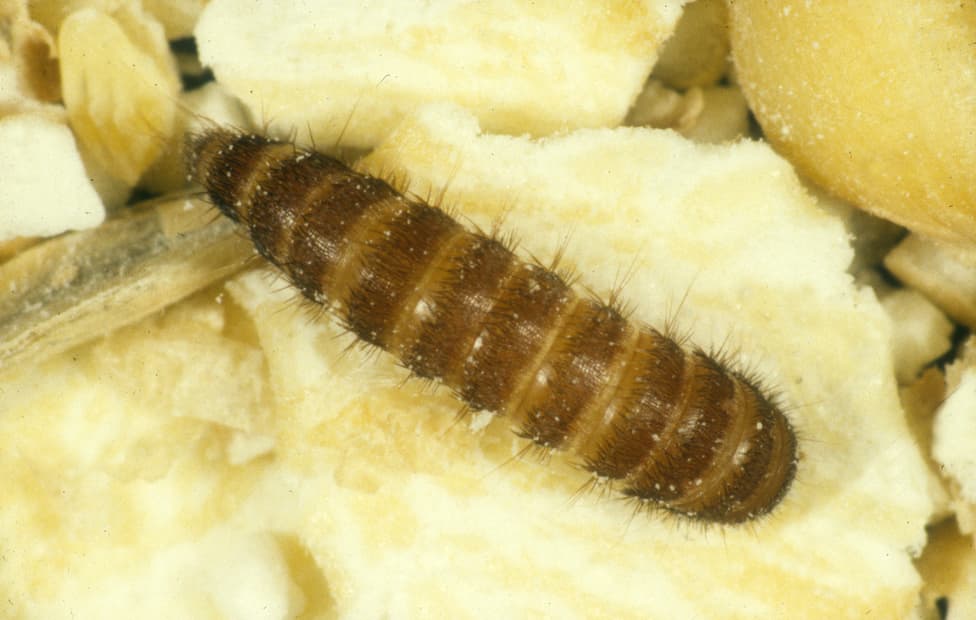
In the larval stage, an infestation of Black Carpet Beetles is at its most devastating. Larval food sources include dead insects, wool, silk, feathers, cotton, and leather. Much like clothes moths, no natural fabrics or fibers are safe from Black Carpet Beetle larvae infestation.
Baby Black Carpet Beetle
Black Carpet Beetles don’t have babies as such. Instead, they have larvae, as discussed above.
Adult Black Carpet Beetles lay eggs, which hatch into larvae. Eventually, those larvae pupate (go through metamorphosis) and emerge as white adult carpet beetles.
As time goes by, the adults darken to become dark brown and finally black.
The adults will lay more eggs, and each stage will repeat itself.
Black Carpet Beetle Size
Black Carpet Beetles aren’t the largest pests in the world.

Black and Brown Carpet Beetle
For many people, there’s some confusion about Black Carpet Beetles and brown ones.
While there are several types of carpet beetle, the Black Carpet Beetle is the most common. These beetles can be white, brown, or black, depending on how old the adults are.
When the larvae pupate, the adults emerge white. After that, they will gradually darken as they age, till they’re the standard black color.
If you see a brown carpet beetle, the chances are that it’s just a young black carpet beetle.
Black Carpet Beetle Bites
People often wrongly think that they have Black Carpet Beetle bites.
These pests don’t consider you a valuable food source. They’re scavengers, and they may eat the hair you’ve shed, but carpet beetles DO NOT bite people.
The main reason for this misconception is that some people get a rash when carpet beetles move into their carpet, rugs, or bedding.
The larvae of these beetles have a covering of brown hair. Many people are allergic to the larva’s shed skins and the brown hair on those skins.

- Red eyes (they may itch or water)
- A rash
- Itchy skin
- Hives
- Tummy problems
- A runny nose

Where Does the Black Carpet Beetle Come From?
This is a multifaceted question that has two different answers. I’ll discuss how black carpet beetles get into your home first, and then their origin.
There’s no great mystery to how black carpet beetles get into your home. In the wild, these beetles are decomposers in the larval stage. Adult beetles use their strong sense of smell to find dead animals, where they lay their eggs.
Unfortunately, to a carpet beetle, your wool carpets and coats smell like what they are: animal fur that’s no longer alive. The adults use their sense of smell to find a likely food source, then fly to that location and lay eggs.
Beetles may enter through windows, under doors, or even ventilation ports. Alternatively, you may get black carpet beetles in your home by bringing in an infected carpet or item of clothing.
Despite the devastating impact that the Black Carpet Beetle, Attagenus unicolor, has had on North America, it originates elsewhere.
Most scientists believe that Black Carpet Beetles originally came from Europe.
If the Black Carpet Beetle comes from Europe, why isn’t it much of a problem there?
After studying the life cycle of carpet beetles, entomologists (insect scientists) found that the Black Carpet Beetle can breed faster in humid climates.
Theoretically, since much of the United States has higher humidity levels than the cooler parts of Europe, carpet beetles can produce more offspring every year.
This increase in offspring leads to more adults looking for places to lay their eggs.
Unfortunately, your wool or cotton clothing, carpets, and fabrics are an ideal place for them to feed.
How to Avoid a Black Carpet Beetle Infestation
The best way to manage Black Carpet Beetles is to control the problem before it arises.
There’s no 100% foolproof way of preventing these beetles from finding your home, but there are steps you can take.
If you live in a place where Black Carpet Beetles are a common problem, or you expect they may be, try the following:
- Remove potential food sources by vacuuming regularly – adult carpet beetles are attracted to any animal-based and natural materials. Vacuuming regularly will help remove attractive food sources like:
- Human and pet hair
- Lint
- Feathers
- Dead insects
- Dust
- Steam clean your carpet, rugs, and bedding at least once a month.
- Ensure that any natural fabric, clothes, materials, and decorative elements are stored in airtight containers if you live in areas where these beetles are common. Potential problem materials include wool, silk, feathers, leather, and cotton.
- Ensure that you store things like jerky in airtight containers.
- Check any new rug, carpet, materials, or clothes for signs of beetle infestation. It’s easy to introduce a colony to your home accidentally.
- Control your environment by steaming furniture and putting natural fiber clothing and bedding through a hot wash cycle every couple of months.
- Add Naphthalene, or other poisons for clothes moths, to trunks of blankets and clothes in storage.
- Regularly treat your carpets with Boric acid to preempt any fledgling infestation.
What Do Black Carpet Beetle Eggs Look Like?
Black Carpet Beetles lay oval-shaped, cream-white eggs. Each of them is only around one-thousandth of an inch long.
Carpet beetles lay their eggs in secluded places that offer food sources.
Although the eggs are too small for you to spot easily, you may find them in lint, along the edges of carpets, or in the pockets and under the collars of coats.
Carpet Beetles may also lay their eggs in the fold of cotton and wool blankets.
Any warm, dark, secluded places (including the lint that forms around windows) is ideal for Black Carpet Beetles to lay eggs.
As with clothes moths, these beetles tend to lay eggs near food sources. So don’t just keep an eye on clothing and carpet, but any articles made of natural material.
Jerky, cotton wool, skin cells, and hair all make a tasty food source.
Keep your surrounding areas clean, your hairbrush tidy, and your food adequately packaged so that you won’t entice any Black Carpet Beetles into your home.
Black Carpet Beetle Larvae
Between nine and 16 days after the adult Black Carpet Beetle lays an egg, it will hatch into a larva.
If you’re looking for identification markers of a Carpet Beetle larva, they’re easy to spot.
Black Carpet Beetle larvae and those of other carpet beetle species go by the name ‘wooly bear.’ They get this name from their wooly appearance and slow, lumbering movements.
The larvae are around five-sixteenths of an inch long, making them hard to spot with the naked eye.
A decent magnifying glass will help you spot the brown hairs on the body of the larva. The size and reddish-brown hairs of the elongated oval-shaped larvae make identification easy.

In the larval stage, an infestation of Black Carpet Beetles is at its most devastating. Larval food sources include dead insects, wool, silk, feathers, cotton, and leather. Much like clothes moths, no natural fabrics or fibers are safe from Black Carpet Beetle larvae infestation.
Baby Black Carpet Beetle
Black Carpet Beetles don’t have babies as such. Instead, they have larvae, as discussed above.
Adult Black Carpet Beetles lay eggs, which hatch into larvae. Eventually, those larvae pupate (go through metamorphosis) and emerge as white adult carpet beetles.
As time goes by, the adults darken to become dark brown and finally black.
The adults will lay more eggs, and each stage will repeat itself.
Black Carpet Beetle Size
Black Carpet Beetles aren’t the largest pests in the world.

Black and Brown Carpet Beetle
For many people, there’s some confusion about Black Carpet Beetles and brown ones.
While there are several types of carpet beetle, the Black Carpet Beetle is the most common. These beetles can be white, brown, or black, depending on how old the adults are.
When the larvae pupate, the adults emerge white. After that, they will gradually darken as they age, till they’re the standard black color.
If you see a brown carpet beetle, the chances are that it’s just a young black carpet beetle.
Black Carpet Beetle Bites
People often wrongly think that they have Black Carpet Beetle bites.
These pests don’t consider you a valuable food source. They’re scavengers, and they may eat the hair you’ve shed, but carpet beetles DO NOT bite people.
The main reason for this misconception is that some people get a rash when carpet beetles move into their carpet, rugs, or bedding.
The larvae of these beetles have a covering of brown hair. Many people are allergic to the larva’s shed skins and the brown hair on those skins.

- Red eyes (they may itch or water)
- A rash
- Itchy skin
- Hives
- Tummy problems
- A runny nose
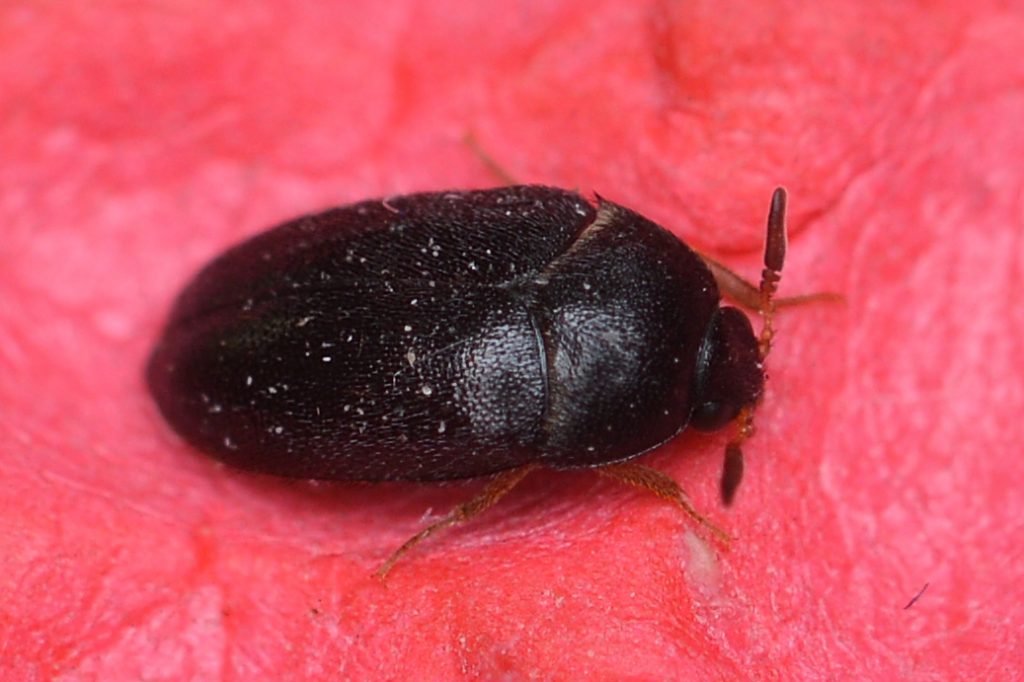
How to Get Rid of Black Carpet Beetle
Many different pest control methods can help remove these beetles. Options include:
- Professional pest control services – By far, the easiest way to get rid of Black Carpet Beetles is to call in pest control services. Pest control companies have a lot of experience with exterminating these beetles. It can be costly to turn to professionals, but it’s efficient.
- DIY room foggers – DIY foggers are a much cheaper option but may not be as effective. Choose a product (like this one from Raid) that’s effective for Black Carpet Beetles (according to the packaging) and follow the directions.
- Natural pest control options – There are several natural ways to help remove carpet beetles from your home. You can read more about those in the section after the next one.
How to Get Rid of Black Carpet Beetle Larvae?
If you decide to go the easy route and call pest control, they’re likely to fumigate your entire home.
When they’ve done the fumigation, and the gases have cleared, you can vacuum your rugs and carpet to get rid of the dead larvae.
You’ll also need to wash or steam any fabric, clothing, rugs, and other materials that can maintain an infestation.
If you’re dealing with small rugs, clothing, or other small to medium-sized articles, consider the freezer.
Whether it’s an egg, a larva, or an adult Black Carpet Beetle, this pest is sensitive to extreme temperature.
If the infested articles are washable, you can put them through a high-temperature wash cycle. If not, place them in a Ziploc bag in the freezer for 6-12 hours.
A very high or very low temperature works equally well for destroying this pest.
After killing the larvae, focus on cleaning. The central aspect to removing the larvae lies in steaming, vacuuming, and washing the infested items.
If you really don’t care about the carpets, consider ripping them out and installing a floating floor instead.
How to Get Rid of Black Carpet Beetles Naturally
If you prefer getting rid of pests naturally, you can use a couple of things against Black Carpet Beetles.
As with any attempt to clear your house and carpets of a Black Carpet Beetle infestation, the main focus is cleaning.
To entirely remove carpet beetles from your home, you need to get rid of every egg and larva in the carpet. This process consists of several steps.
- Vacuum the carpet thoroughly. If you don’t have a vacuum with a roller brush, consider hiring one for the day (or check out my vacuum guide and buy an upgrade). A deep vacuuming will help remove eggs and larvae.
- Wash the carpet with a carpet cleaner to help eradicate any egg, larva, or adult that the vacuum may have missed.
- Allow the carpet to dry thoroughly.
- Sprinkle boric acid over the carpet and use a broom to work it in. Boric acid is a natural insecticide, so you don’t have to worry about toxic chemicals.
- After a day or two, vacuum the carpet again to remove the dead insects from the carpet.
- Vacuum your entire home, removing all lint, dust, hair, and other potential food sources.
- Steam clean your clothes, rugs, furniture, fabric, and other articles of furniture that could house eggs or larvae. Anything that contains animal-based or natural fibers is at risk.
- Make a solution of apple cider or white wine vinegar and water. Fill a spray bottle with the solution and spray any surfaces where dust, hair, or dead insects may be. Pay special attention to furniture and areas around windows. It will help repel the beetles from your home.
- Put your pillows, bedding, and clothing through a hot wash cycle to kill any eggs and larvae that may be living in them.

Where Does the Black Carpet Beetle Come From?
This is a multifaceted question that has two different answers. I’ll discuss how black carpet beetles get into your home first, and then their origin.
There’s no great mystery to how black carpet beetles get into your home. In the wild, these beetles are decomposers in the larval stage. Adult beetles use their strong sense of smell to find dead animals, where they lay their eggs.
Unfortunately, to a carpet beetle, your wool carpets and coats smell like what they are: animal fur that’s no longer alive. The adults use their sense of smell to find a likely food source, then fly to that location and lay eggs.
Beetles may enter through windows, under doors, or even ventilation ports. Alternatively, you may get black carpet beetles in your home by bringing in an infected carpet or item of clothing.
Despite the devastating impact that the Black Carpet Beetle, Attagenus unicolor, has had on North America, it originates elsewhere.
Most scientists believe that Black Carpet Beetles originally came from Europe.
If the Black Carpet Beetle comes from Europe, why isn’t it much of a problem there?
After studying the life cycle of carpet beetles, entomologists (insect scientists) found that the Black Carpet Beetle can breed faster in humid climates.
Theoretically, since much of the United States has higher humidity levels than the cooler parts of Europe, carpet beetles can produce more offspring every year.
This increase in offspring leads to more adults looking for places to lay their eggs.
Unfortunately, your wool or cotton clothing, carpets, and fabrics are an ideal place for them to feed.
How to Avoid a Black Carpet Beetle Infestation
The best way to manage Black Carpet Beetles is to control the problem before it arises.
There’s no 100% foolproof way of preventing these beetles from finding your home, but there are steps you can take.
If you live in a place where Black Carpet Beetles are a common problem, or you expect they may be, try the following:
- Remove potential food sources by vacuuming regularly – adult carpet beetles are attracted to any animal-based and natural materials. Vacuuming regularly will help remove attractive food sources like:
- Human and pet hair
- Lint
- Feathers
- Dead insects
- Dust
- Steam clean your carpet, rugs, and bedding at least once a month.
- Ensure that any natural fabric, clothes, materials, and decorative elements are stored in airtight containers if you live in areas where these beetles are common. Potential problem materials include wool, silk, feathers, leather, and cotton.
- Ensure that you store things like jerky in airtight containers.
- Check any new rug, carpet, materials, or clothes for signs of beetle infestation. It’s easy to introduce a colony to your home accidentally.
- Control your environment by steaming furniture and putting natural fiber clothing and bedding through a hot wash cycle every couple of months.
- Add Naphthalene, or other poisons for clothes moths, to trunks of blankets and clothes in storage.
- Regularly treat your carpets with Boric acid to preempt any fledgling infestation.
What Do Black Carpet Beetle Eggs Look Like?
Black Carpet Beetles lay oval-shaped, cream-white eggs. Each of them is only around one-thousandth of an inch long.
Carpet beetles lay their eggs in secluded places that offer food sources.
Although the eggs are too small for you to spot easily, you may find them in lint, along the edges of carpets, or in the pockets and under the collars of coats.
Carpet Beetles may also lay their eggs in the fold of cotton and wool blankets.
Any warm, dark, secluded places (including the lint that forms around windows) is ideal for Black Carpet Beetles to lay eggs.
As with clothes moths, these beetles tend to lay eggs near food sources. So don’t just keep an eye on clothing and carpet, but any articles made of natural material.
Jerky, cotton wool, skin cells, and hair all make a tasty food source.
Keep your surrounding areas clean, your hairbrush tidy, and your food adequately packaged so that you won’t entice any Black Carpet Beetles into your home.
Black Carpet Beetle Larvae
Between nine and 16 days after the adult Black Carpet Beetle lays an egg, it will hatch into a larva.
If you’re looking for identification markers of a Carpet Beetle larva, they’re easy to spot.
Black Carpet Beetle larvae and those of other carpet beetle species go by the name ‘wooly bear.’ They get this name from their wooly appearance and slow, lumbering movements.
The larvae are around five-sixteenths of an inch long, making them hard to spot with the naked eye.
A decent magnifying glass will help you spot the brown hairs on the body of the larva. The size and reddish-brown hairs of the elongated oval-shaped larvae make identification easy.

In the larval stage, an infestation of Black Carpet Beetles is at its most devastating. Larval food sources include dead insects, wool, silk, feathers, cotton, and leather. Much like clothes moths, no natural fabrics or fibers are safe from Black Carpet Beetle larvae infestation.
Baby Black Carpet Beetle
Black Carpet Beetles don’t have babies as such. Instead, they have larvae, as discussed above.
Adult Black Carpet Beetles lay eggs, which hatch into larvae. Eventually, those larvae pupate (go through metamorphosis) and emerge as white adult carpet beetles.
As time goes by, the adults darken to become dark brown and finally black.
The adults will lay more eggs, and each stage will repeat itself.
Black Carpet Beetle Size
Black Carpet Beetles aren’t the largest pests in the world.

Black and Brown Carpet Beetle
For many people, there’s some confusion about Black Carpet Beetles and brown ones.
While there are several types of carpet beetle, the Black Carpet Beetle is the most common. These beetles can be white, brown, or black, depending on how old the adults are.
When the larvae pupate, the adults emerge white. After that, they will gradually darken as they age, till they’re the standard black color.
If you see a brown carpet beetle, the chances are that it’s just a young black carpet beetle.
Black Carpet Beetle Bites
People often wrongly think that they have Black Carpet Beetle bites.
These pests don’t consider you a valuable food source. They’re scavengers, and they may eat the hair you’ve shed, but carpet beetles DO NOT bite people.
The main reason for this misconception is that some people get a rash when carpet beetles move into their carpet, rugs, or bedding.
The larvae of these beetles have a covering of brown hair. Many people are allergic to the larva’s shed skins and the brown hair on those skins.

- Red eyes (they may itch or water)
- A rash
- Itchy skin
- Hives
- Tummy problems
- A runny nose
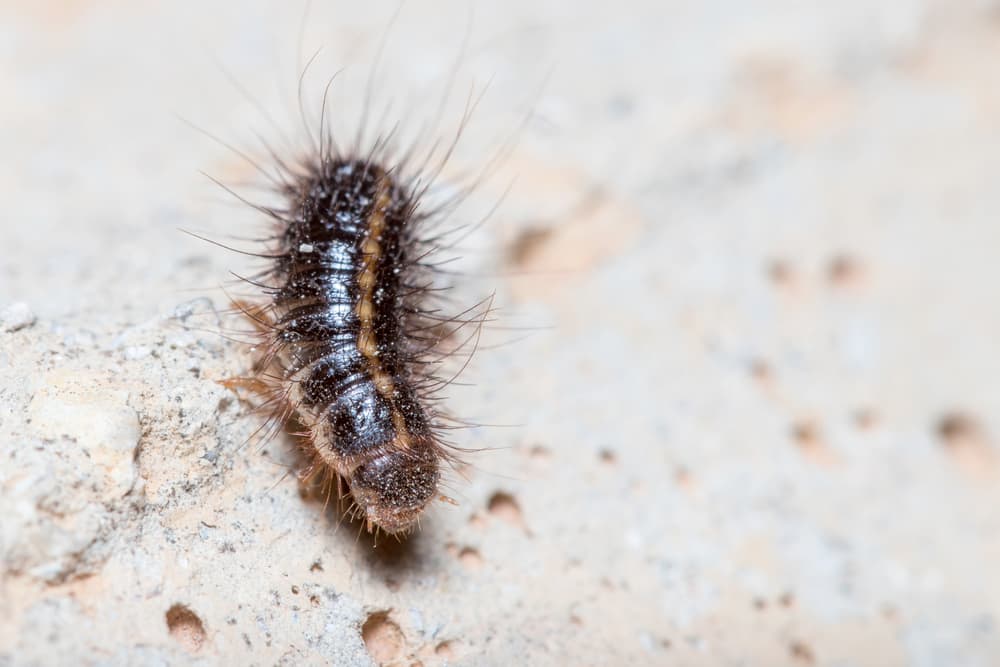
Adults – Reach lengths of around a tenth of an inch (the size of a small bead). May be white, brown, or black, depending on the age. Typically found around natural materials like wool, cotton, or leather.

How to Get Rid of Black Carpet Beetle
Many different pest control methods can help remove these beetles. Options include:
- Professional pest control services – By far, the easiest way to get rid of Black Carpet Beetles is to call in pest control services. Pest control companies have a lot of experience with exterminating these beetles. It can be costly to turn to professionals, but it’s efficient.
- DIY room foggers – DIY foggers are a much cheaper option but may not be as effective. Choose a product (like this one from Raid) that’s effective for Black Carpet Beetles (according to the packaging) and follow the directions.
- Natural pest control options – There are several natural ways to help remove carpet beetles from your home. You can read more about those in the section after the next one.
How to Get Rid of Black Carpet Beetle Larvae?
If you decide to go the easy route and call pest control, they’re likely to fumigate your entire home.
When they’ve done the fumigation, and the gases have cleared, you can vacuum your rugs and carpet to get rid of the dead larvae.
You’ll also need to wash or steam any fabric, clothing, rugs, and other materials that can maintain an infestation.
If you’re dealing with small rugs, clothing, or other small to medium-sized articles, consider the freezer.
Whether it’s an egg, a larva, or an adult Black Carpet Beetle, this pest is sensitive to extreme temperature.
If the infested articles are washable, you can put them through a high-temperature wash cycle. If not, place them in a Ziploc bag in the freezer for 6-12 hours.
A very high or very low temperature works equally well for destroying this pest.
After killing the larvae, focus on cleaning. The central aspect to removing the larvae lies in steaming, vacuuming, and washing the infested items.
If you really don’t care about the carpets, consider ripping them out and installing a floating floor instead.
How to Get Rid of Black Carpet Beetles Naturally
If you prefer getting rid of pests naturally, you can use a couple of things against Black Carpet Beetles.
As with any attempt to clear your house and carpets of a Black Carpet Beetle infestation, the main focus is cleaning.
To entirely remove carpet beetles from your home, you need to get rid of every egg and larva in the carpet. This process consists of several steps.
- Vacuum the carpet thoroughly. If you don’t have a vacuum with a roller brush, consider hiring one for the day (or check out my vacuum guide and buy an upgrade). A deep vacuuming will help remove eggs and larvae.
- Wash the carpet with a carpet cleaner to help eradicate any egg, larva, or adult that the vacuum may have missed.
- Allow the carpet to dry thoroughly.
- Sprinkle boric acid over the carpet and use a broom to work it in. Boric acid is a natural insecticide, so you don’t have to worry about toxic chemicals.
- After a day or two, vacuum the carpet again to remove the dead insects from the carpet.
- Vacuum your entire home, removing all lint, dust, hair, and other potential food sources.
- Steam clean your clothes, rugs, furniture, fabric, and other articles of furniture that could house eggs or larvae. Anything that contains animal-based or natural fibers is at risk.
- Make a solution of apple cider or white wine vinegar and water. Fill a spray bottle with the solution and spray any surfaces where dust, hair, or dead insects may be. Pay special attention to furniture and areas around windows. It will help repel the beetles from your home.
- Put your pillows, bedding, and clothing through a hot wash cycle to kill any eggs and larvae that may be living in them.

Where Does the Black Carpet Beetle Come From?
This is a multifaceted question that has two different answers. I’ll discuss how black carpet beetles get into your home first, and then their origin.
There’s no great mystery to how black carpet beetles get into your home. In the wild, these beetles are decomposers in the larval stage. Adult beetles use their strong sense of smell to find dead animals, where they lay their eggs.
Unfortunately, to a carpet beetle, your wool carpets and coats smell like what they are: animal fur that’s no longer alive. The adults use their sense of smell to find a likely food source, then fly to that location and lay eggs.
Beetles may enter through windows, under doors, or even ventilation ports. Alternatively, you may get black carpet beetles in your home by bringing in an infected carpet or item of clothing.
Despite the devastating impact that the Black Carpet Beetle, Attagenus unicolor, has had on North America, it originates elsewhere.
Most scientists believe that Black Carpet Beetles originally came from Europe.
If the Black Carpet Beetle comes from Europe, why isn’t it much of a problem there?
After studying the life cycle of carpet beetles, entomologists (insect scientists) found that the Black Carpet Beetle can breed faster in humid climates.
Theoretically, since much of the United States has higher humidity levels than the cooler parts of Europe, carpet beetles can produce more offspring every year.
This increase in offspring leads to more adults looking for places to lay their eggs.
Unfortunately, your wool or cotton clothing, carpets, and fabrics are an ideal place for them to feed.
How to Avoid a Black Carpet Beetle Infestation
The best way to manage Black Carpet Beetles is to control the problem before it arises.
There’s no 100% foolproof way of preventing these beetles from finding your home, but there are steps you can take.
If you live in a place where Black Carpet Beetles are a common problem, or you expect they may be, try the following:
- Remove potential food sources by vacuuming regularly – adult carpet beetles are attracted to any animal-based and natural materials. Vacuuming regularly will help remove attractive food sources like:
- Human and pet hair
- Lint
- Feathers
- Dead insects
- Dust
- Steam clean your carpet, rugs, and bedding at least once a month.
- Ensure that any natural fabric, clothes, materials, and decorative elements are stored in airtight containers if you live in areas where these beetles are common. Potential problem materials include wool, silk, feathers, leather, and cotton.
- Ensure that you store things like jerky in airtight containers.
- Check any new rug, carpet, materials, or clothes for signs of beetle infestation. It’s easy to introduce a colony to your home accidentally.
- Control your environment by steaming furniture and putting natural fiber clothing and bedding through a hot wash cycle every couple of months.
- Add Naphthalene, or other poisons for clothes moths, to trunks of blankets and clothes in storage.
- Regularly treat your carpets with Boric acid to preempt any fledgling infestation.
What Do Black Carpet Beetle Eggs Look Like?
Black Carpet Beetles lay oval-shaped, cream-white eggs. Each of them is only around one-thousandth of an inch long.
Carpet beetles lay their eggs in secluded places that offer food sources.
Although the eggs are too small for you to spot easily, you may find them in lint, along the edges of carpets, or in the pockets and under the collars of coats.
Carpet Beetles may also lay their eggs in the fold of cotton and wool blankets.
Any warm, dark, secluded places (including the lint that forms around windows) is ideal for Black Carpet Beetles to lay eggs.
As with clothes moths, these beetles tend to lay eggs near food sources. So don’t just keep an eye on clothing and carpet, but any articles made of natural material.
Jerky, cotton wool, skin cells, and hair all make a tasty food source.
Keep your surrounding areas clean, your hairbrush tidy, and your food adequately packaged so that you won’t entice any Black Carpet Beetles into your home.
Black Carpet Beetle Larvae
Between nine and 16 days after the adult Black Carpet Beetle lays an egg, it will hatch into a larva.
If you’re looking for identification markers of a Carpet Beetle larva, they’re easy to spot.
Black Carpet Beetle larvae and those of other carpet beetle species go by the name ‘wooly bear.’ They get this name from their wooly appearance and slow, lumbering movements.
The larvae are around five-sixteenths of an inch long, making them hard to spot with the naked eye.
A decent magnifying glass will help you spot the brown hairs on the body of the larva. The size and reddish-brown hairs of the elongated oval-shaped larvae make identification easy.

In the larval stage, an infestation of Black Carpet Beetles is at its most devastating. Larval food sources include dead insects, wool, silk, feathers, cotton, and leather. Much like clothes moths, no natural fabrics or fibers are safe from Black Carpet Beetle larvae infestation.
Baby Black Carpet Beetle
Black Carpet Beetles don’t have babies as such. Instead, they have larvae, as discussed above.
Adult Black Carpet Beetles lay eggs, which hatch into larvae. Eventually, those larvae pupate (go through metamorphosis) and emerge as white adult carpet beetles.
As time goes by, the adults darken to become dark brown and finally black.
The adults will lay more eggs, and each stage will repeat itself.
Black Carpet Beetle Size
Black Carpet Beetles aren’t the largest pests in the world.

Black and Brown Carpet Beetle
For many people, there’s some confusion about Black Carpet Beetles and brown ones.
While there are several types of carpet beetle, the Black Carpet Beetle is the most common. These beetles can be white, brown, or black, depending on how old the adults are.
When the larvae pupate, the adults emerge white. After that, they will gradually darken as they age, till they’re the standard black color.
If you see a brown carpet beetle, the chances are that it’s just a young black carpet beetle.
Black Carpet Beetle Bites
People often wrongly think that they have Black Carpet Beetle bites.
These pests don’t consider you a valuable food source. They’re scavengers, and they may eat the hair you’ve shed, but carpet beetles DO NOT bite people.
The main reason for this misconception is that some people get a rash when carpet beetles move into their carpet, rugs, or bedding.
The larvae of these beetles have a covering of brown hair. Many people are allergic to the larva’s shed skins and the brown hair on those skins.

- Red eyes (they may itch or water)
- A rash
- Itchy skin
- Hives
- Tummy problems
- A runny nose
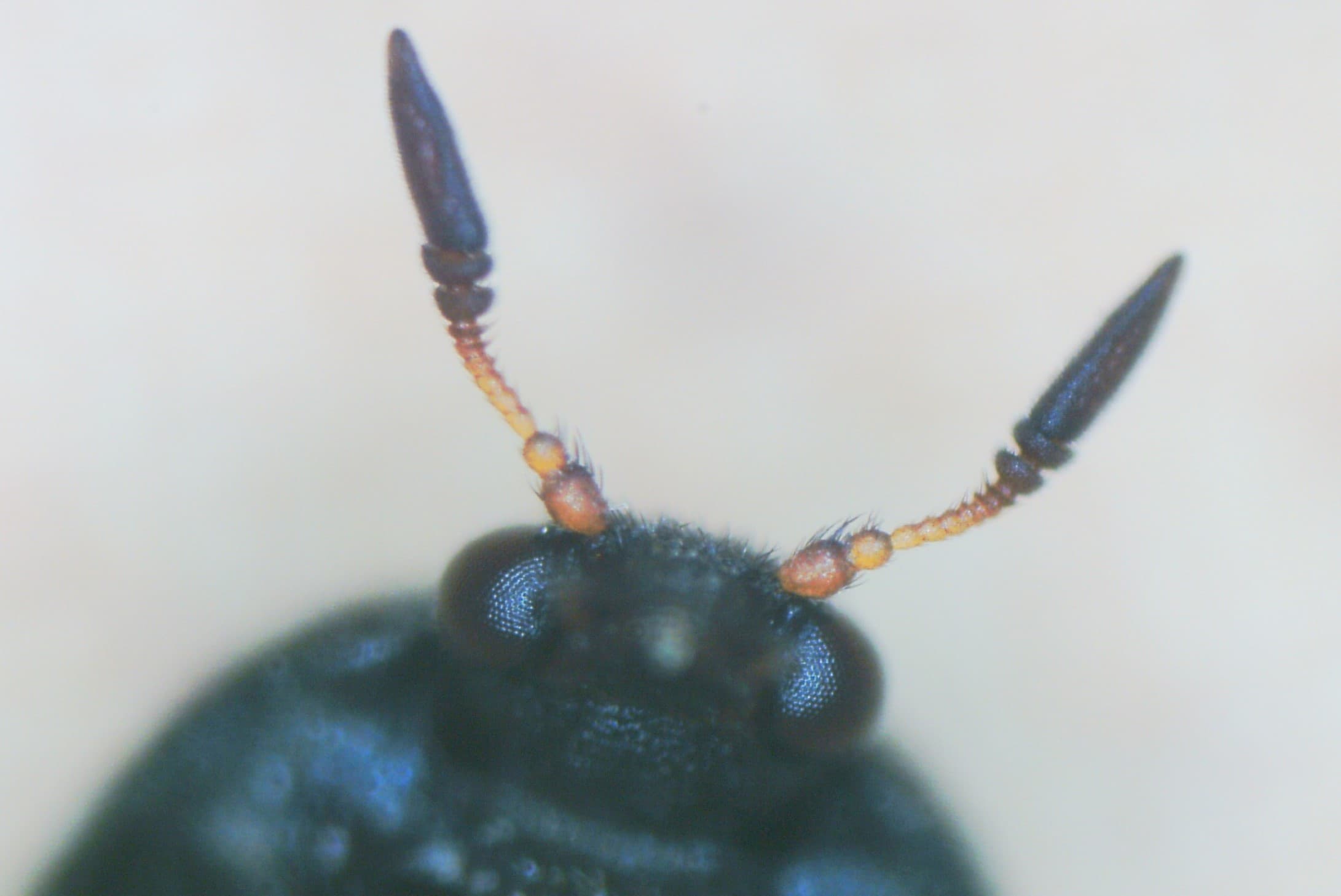
Identifying Black Carpet Beetles
It’s easy to identify Black Carpet Beetles if you know what you’re looking for. Here’s a cheat sheet to help you identify your pests if they’re carpet beetles.
Eggs – Around one-thousandth of an inch long (that’s about the size of a pinprick), creamy-white, and oval-shaped. Found in lint or the folds of carpets, rugs, wool, and other natural materials.
Larvae – Up to five-sixteenths of an inch long (about as long as a TicTac is wide). Light brown, covered in dark brown hairs. Elongated and roughly oval-shaped. Evidence of larvae includes many shed skins.

Adults – Reach lengths of around a tenth of an inch (the size of a small bead). May be white, brown, or black, depending on the age. Typically found around natural materials like wool, cotton, or leather.

How to Get Rid of Black Carpet Beetle
Many different pest control methods can help remove these beetles. Options include:
- Professional pest control services – By far, the easiest way to get rid of Black Carpet Beetles is to call in pest control services. Pest control companies have a lot of experience with exterminating these beetles. It can be costly to turn to professionals, but it’s efficient.
- DIY room foggers – DIY foggers are a much cheaper option but may not be as effective. Choose a product (like this one from Raid) that’s effective for Black Carpet Beetles (according to the packaging) and follow the directions.
- Natural pest control options – There are several natural ways to help remove carpet beetles from your home. You can read more about those in the section after the next one.
How to Get Rid of Black Carpet Beetle Larvae?
If you decide to go the easy route and call pest control, they’re likely to fumigate your entire home.
When they’ve done the fumigation, and the gases have cleared, you can vacuum your rugs and carpet to get rid of the dead larvae.
You’ll also need to wash or steam any fabric, clothing, rugs, and other materials that can maintain an infestation.
If you’re dealing with small rugs, clothing, or other small to medium-sized articles, consider the freezer.
Whether it’s an egg, a larva, or an adult Black Carpet Beetle, this pest is sensitive to extreme temperature.
If the infested articles are washable, you can put them through a high-temperature wash cycle. If not, place them in a Ziploc bag in the freezer for 6-12 hours.
A very high or very low temperature works equally well for destroying this pest.
After killing the larvae, focus on cleaning. The central aspect to removing the larvae lies in steaming, vacuuming, and washing the infested items.
If you really don’t care about the carpets, consider ripping them out and installing a floating floor instead.
How to Get Rid of Black Carpet Beetles Naturally
If you prefer getting rid of pests naturally, you can use a couple of things against Black Carpet Beetles.
As with any attempt to clear your house and carpets of a Black Carpet Beetle infestation, the main focus is cleaning.
To entirely remove carpet beetles from your home, you need to get rid of every egg and larva in the carpet. This process consists of several steps.
- Vacuum the carpet thoroughly. If you don’t have a vacuum with a roller brush, consider hiring one for the day (or check out my vacuum guide and buy an upgrade). A deep vacuuming will help remove eggs and larvae.
- Wash the carpet with a carpet cleaner to help eradicate any egg, larva, or adult that the vacuum may have missed.
- Allow the carpet to dry thoroughly.
- Sprinkle boric acid over the carpet and use a broom to work it in. Boric acid is a natural insecticide, so you don’t have to worry about toxic chemicals.
- After a day or two, vacuum the carpet again to remove the dead insects from the carpet.
- Vacuum your entire home, removing all lint, dust, hair, and other potential food sources.
- Steam clean your clothes, rugs, furniture, fabric, and other articles of furniture that could house eggs or larvae. Anything that contains animal-based or natural fibers is at risk.
- Make a solution of apple cider or white wine vinegar and water. Fill a spray bottle with the solution and spray any surfaces where dust, hair, or dead insects may be. Pay special attention to furniture and areas around windows. It will help repel the beetles from your home.
- Put your pillows, bedding, and clothing through a hot wash cycle to kill any eggs and larvae that may be living in them.

Where Does the Black Carpet Beetle Come From?
This is a multifaceted question that has two different answers. I’ll discuss how black carpet beetles get into your home first, and then their origin.
There’s no great mystery to how black carpet beetles get into your home. In the wild, these beetles are decomposers in the larval stage. Adult beetles use their strong sense of smell to find dead animals, where they lay their eggs.
Unfortunately, to a carpet beetle, your wool carpets and coats smell like what they are: animal fur that’s no longer alive. The adults use their sense of smell to find a likely food source, then fly to that location and lay eggs.
Beetles may enter through windows, under doors, or even ventilation ports. Alternatively, you may get black carpet beetles in your home by bringing in an infected carpet or item of clothing.
Despite the devastating impact that the Black Carpet Beetle, Attagenus unicolor, has had on North America, it originates elsewhere.
Most scientists believe that Black Carpet Beetles originally came from Europe.
If the Black Carpet Beetle comes from Europe, why isn’t it much of a problem there?
After studying the life cycle of carpet beetles, entomologists (insect scientists) found that the Black Carpet Beetle can breed faster in humid climates.
Theoretically, since much of the United States has higher humidity levels than the cooler parts of Europe, carpet beetles can produce more offspring every year.
This increase in offspring leads to more adults looking for places to lay their eggs.
Unfortunately, your wool or cotton clothing, carpets, and fabrics are an ideal place for them to feed.
How to Avoid a Black Carpet Beetle Infestation
The best way to manage Black Carpet Beetles is to control the problem before it arises.
There’s no 100% foolproof way of preventing these beetles from finding your home, but there are steps you can take.
If you live in a place where Black Carpet Beetles are a common problem, or you expect they may be, try the following:
- Remove potential food sources by vacuuming regularly – adult carpet beetles are attracted to any animal-based and natural materials. Vacuuming regularly will help remove attractive food sources like:
- Human and pet hair
- Lint
- Feathers
- Dead insects
- Dust
- Steam clean your carpet, rugs, and bedding at least once a month.
- Ensure that any natural fabric, clothes, materials, and decorative elements are stored in airtight containers if you live in areas where these beetles are common. Potential problem materials include wool, silk, feathers, leather, and cotton.
- Ensure that you store things like jerky in airtight containers.
- Check any new rug, carpet, materials, or clothes for signs of beetle infestation. It’s easy to introduce a colony to your home accidentally.
- Control your environment by steaming furniture and putting natural fiber clothing and bedding through a hot wash cycle every couple of months.
- Add Naphthalene, or other poisons for clothes moths, to trunks of blankets and clothes in storage.
- Regularly treat your carpets with Boric acid to preempt any fledgling infestation.
What Do Black Carpet Beetle Eggs Look Like?
Black Carpet Beetles lay oval-shaped, cream-white eggs. Each of them is only around one-thousandth of an inch long.
Carpet beetles lay their eggs in secluded places that offer food sources.
Although the eggs are too small for you to spot easily, you may find them in lint, along the edges of carpets, or in the pockets and under the collars of coats.
Carpet Beetles may also lay their eggs in the fold of cotton and wool blankets.
Any warm, dark, secluded places (including the lint that forms around windows) is ideal for Black Carpet Beetles to lay eggs.
As with clothes moths, these beetles tend to lay eggs near food sources. So don’t just keep an eye on clothing and carpet, but any articles made of natural material.
Jerky, cotton wool, skin cells, and hair all make a tasty food source.
Keep your surrounding areas clean, your hairbrush tidy, and your food adequately packaged so that you won’t entice any Black Carpet Beetles into your home.
Black Carpet Beetle Larvae
Between nine and 16 days after the adult Black Carpet Beetle lays an egg, it will hatch into a larva.
If you’re looking for identification markers of a Carpet Beetle larva, they’re easy to spot.
Black Carpet Beetle larvae and those of other carpet beetle species go by the name ‘wooly bear.’ They get this name from their wooly appearance and slow, lumbering movements.
The larvae are around five-sixteenths of an inch long, making them hard to spot with the naked eye.
A decent magnifying glass will help you spot the brown hairs on the body of the larva. The size and reddish-brown hairs of the elongated oval-shaped larvae make identification easy.

In the larval stage, an infestation of Black Carpet Beetles is at its most devastating. Larval food sources include dead insects, wool, silk, feathers, cotton, and leather. Much like clothes moths, no natural fabrics or fibers are safe from Black Carpet Beetle larvae infestation.
Baby Black Carpet Beetle
Black Carpet Beetles don’t have babies as such. Instead, they have larvae, as discussed above.
Adult Black Carpet Beetles lay eggs, which hatch into larvae. Eventually, those larvae pupate (go through metamorphosis) and emerge as white adult carpet beetles.
As time goes by, the adults darken to become dark brown and finally black.
The adults will lay more eggs, and each stage will repeat itself.
Black Carpet Beetle Size
Black Carpet Beetles aren’t the largest pests in the world.

Black and Brown Carpet Beetle
For many people, there’s some confusion about Black Carpet Beetles and brown ones.
While there are several types of carpet beetle, the Black Carpet Beetle is the most common. These beetles can be white, brown, or black, depending on how old the adults are.
When the larvae pupate, the adults emerge white. After that, they will gradually darken as they age, till they’re the standard black color.
If you see a brown carpet beetle, the chances are that it’s just a young black carpet beetle.
Black Carpet Beetle Bites
People often wrongly think that they have Black Carpet Beetle bites.
These pests don’t consider you a valuable food source. They’re scavengers, and they may eat the hair you’ve shed, but carpet beetles DO NOT bite people.
The main reason for this misconception is that some people get a rash when carpet beetles move into their carpet, rugs, or bedding.
The larvae of these beetles have a covering of brown hair. Many people are allergic to the larva’s shed skins and the brown hair on those skins.

- Red eyes (they may itch or water)
- A rash
- Itchy skin
- Hives
- Tummy problems
- A runny nose
How to Get Rid of Black Carpet Beetle?
The Black Carpet Beetle is a decomposer that causes a problem when it lays eggs on carpets and clothing. The result? A carpet full of holes and frayed edges. Carpet beetles cause the most damage in the larval stage, but you can get rid of them. Intensive cleaning is the key to removing carpet beetles and their larvae, and there are natural and chemical means to kill them. Join me to learn more about these enterprising insects and how you can protect your valuable carpets.
What Is a Black Carpet Beetle?
The Black Carpet Beetle, Attagenus unicolor, is an insect that serves the same purpose as flies and other scavengers in the wild.
These fascinating insects help to decompose dead animals, whether they be insects or sheep.
Unfortunately, the strong senses of the Black Carpet Beetle often lead it to think that animal-related products (like wool) need to be processed and removed.

Identifying Black Carpet Beetles
It’s easy to identify Black Carpet Beetles if you know what you’re looking for. Here’s a cheat sheet to help you identify your pests if they’re carpet beetles.
Eggs – Around one-thousandth of an inch long (that’s about the size of a pinprick), creamy-white, and oval-shaped. Found in lint or the folds of carpets, rugs, wool, and other natural materials.
Larvae – Up to five-sixteenths of an inch long (about as long as a TicTac is wide). Light brown, covered in dark brown hairs. Elongated and roughly oval-shaped. Evidence of larvae includes many shed skins.

Adults – Reach lengths of around a tenth of an inch (the size of a small bead). May be white, brown, or black, depending on the age. Typically found around natural materials like wool, cotton, or leather.

How to Get Rid of Black Carpet Beetle
Many different pest control methods can help remove these beetles. Options include:
- Professional pest control services – By far, the easiest way to get rid of Black Carpet Beetles is to call in pest control services. Pest control companies have a lot of experience with exterminating these beetles. It can be costly to turn to professionals, but it’s efficient.
- DIY room foggers – DIY foggers are a much cheaper option but may not be as effective. Choose a product (like this one from Raid) that’s effective for Black Carpet Beetles (according to the packaging) and follow the directions.
- Natural pest control options – There are several natural ways to help remove carpet beetles from your home. You can read more about those in the section after the next one.
How to Get Rid of Black Carpet Beetle Larvae?
If you decide to go the easy route and call pest control, they’re likely to fumigate your entire home.
When they’ve done the fumigation, and the gases have cleared, you can vacuum your rugs and carpet to get rid of the dead larvae.
You’ll also need to wash or steam any fabric, clothing, rugs, and other materials that can maintain an infestation.
If you’re dealing with small rugs, clothing, or other small to medium-sized articles, consider the freezer.
Whether it’s an egg, a larva, or an adult Black Carpet Beetle, this pest is sensitive to extreme temperature.
If the infested articles are washable, you can put them through a high-temperature wash cycle. If not, place them in a Ziploc bag in the freezer for 6-12 hours.
A very high or very low temperature works equally well for destroying this pest.
After killing the larvae, focus on cleaning. The central aspect to removing the larvae lies in steaming, vacuuming, and washing the infested items.
If you really don’t care about the carpets, consider ripping them out and installing a floating floor instead.
How to Get Rid of Black Carpet Beetles Naturally
If you prefer getting rid of pests naturally, you can use a couple of things against Black Carpet Beetles.
As with any attempt to clear your house and carpets of a Black Carpet Beetle infestation, the main focus is cleaning.
To entirely remove carpet beetles from your home, you need to get rid of every egg and larva in the carpet. This process consists of several steps.
- Vacuum the carpet thoroughly. If you don’t have a vacuum with a roller brush, consider hiring one for the day (or check out my vacuum guide and buy an upgrade). A deep vacuuming will help remove eggs and larvae.
- Wash the carpet with a carpet cleaner to help eradicate any egg, larva, or adult that the vacuum may have missed.
- Allow the carpet to dry thoroughly.
- Sprinkle boric acid over the carpet and use a broom to work it in. Boric acid is a natural insecticide, so you don’t have to worry about toxic chemicals.
- After a day or two, vacuum the carpet again to remove the dead insects from the carpet.
- Vacuum your entire home, removing all lint, dust, hair, and other potential food sources.
- Steam clean your clothes, rugs, furniture, fabric, and other articles of furniture that could house eggs or larvae. Anything that contains animal-based or natural fibers is at risk.
- Make a solution of apple cider or white wine vinegar and water. Fill a spray bottle with the solution and spray any surfaces where dust, hair, or dead insects may be. Pay special attention to furniture and areas around windows. It will help repel the beetles from your home.
- Put your pillows, bedding, and clothing through a hot wash cycle to kill any eggs and larvae that may be living in them.

Where Does the Black Carpet Beetle Come From?
This is a multifaceted question that has two different answers. I’ll discuss how black carpet beetles get into your home first, and then their origin.
There’s no great mystery to how black carpet beetles get into your home. In the wild, these beetles are decomposers in the larval stage. Adult beetles use their strong sense of smell to find dead animals, where they lay their eggs.
Unfortunately, to a carpet beetle, your wool carpets and coats smell like what they are: animal fur that’s no longer alive. The adults use their sense of smell to find a likely food source, then fly to that location and lay eggs.
Beetles may enter through windows, under doors, or even ventilation ports. Alternatively, you may get black carpet beetles in your home by bringing in an infected carpet or item of clothing.
Despite the devastating impact that the Black Carpet Beetle, Attagenus unicolor, has had on North America, it originates elsewhere.
Most scientists believe that Black Carpet Beetles originally came from Europe.
If the Black Carpet Beetle comes from Europe, why isn’t it much of a problem there?
After studying the life cycle of carpet beetles, entomologists (insect scientists) found that the Black Carpet Beetle can breed faster in humid climates.
Theoretically, since much of the United States has higher humidity levels than the cooler parts of Europe, carpet beetles can produce more offspring every year.
This increase in offspring leads to more adults looking for places to lay their eggs.
Unfortunately, your wool or cotton clothing, carpets, and fabrics are an ideal place for them to feed.
How to Avoid a Black Carpet Beetle Infestation
The best way to manage Black Carpet Beetles is to control the problem before it arises.
There’s no 100% foolproof way of preventing these beetles from finding your home, but there are steps you can take.
If you live in a place where Black Carpet Beetles are a common problem, or you expect they may be, try the following:
- Remove potential food sources by vacuuming regularly – adult carpet beetles are attracted to any animal-based and natural materials. Vacuuming regularly will help remove attractive food sources like:
- Human and pet hair
- Lint
- Feathers
- Dead insects
- Dust
- Steam clean your carpet, rugs, and bedding at least once a month.
- Ensure that any natural fabric, clothes, materials, and decorative elements are stored in airtight containers if you live in areas where these beetles are common. Potential problem materials include wool, silk, feathers, leather, and cotton.
- Ensure that you store things like jerky in airtight containers.
- Check any new rug, carpet, materials, or clothes for signs of beetle infestation. It’s easy to introduce a colony to your home accidentally.
- Control your environment by steaming furniture and putting natural fiber clothing and bedding through a hot wash cycle every couple of months.
- Add Naphthalene, or other poisons for clothes moths, to trunks of blankets and clothes in storage.
- Regularly treat your carpets with Boric acid to preempt any fledgling infestation.
What Do Black Carpet Beetle Eggs Look Like?
Black Carpet Beetles lay oval-shaped, cream-white eggs. Each of them is only around one-thousandth of an inch long.
Carpet beetles lay their eggs in secluded places that offer food sources.
Although the eggs are too small for you to spot easily, you may find them in lint, along the edges of carpets, or in the pockets and under the collars of coats.
Carpet Beetles may also lay their eggs in the fold of cotton and wool blankets.
Any warm, dark, secluded places (including the lint that forms around windows) is ideal for Black Carpet Beetles to lay eggs.
As with clothes moths, these beetles tend to lay eggs near food sources. So don’t just keep an eye on clothing and carpet, but any articles made of natural material.
Jerky, cotton wool, skin cells, and hair all make a tasty food source.
Keep your surrounding areas clean, your hairbrush tidy, and your food adequately packaged so that you won’t entice any Black Carpet Beetles into your home.
Black Carpet Beetle Larvae
Between nine and 16 days after the adult Black Carpet Beetle lays an egg, it will hatch into a larva.
If you’re looking for identification markers of a Carpet Beetle larva, they’re easy to spot.
Black Carpet Beetle larvae and those of other carpet beetle species go by the name ‘wooly bear.’ They get this name from their wooly appearance and slow, lumbering movements.
The larvae are around five-sixteenths of an inch long, making them hard to spot with the naked eye.
A decent magnifying glass will help you spot the brown hairs on the body of the larva. The size and reddish-brown hairs of the elongated oval-shaped larvae make identification easy.

In the larval stage, an infestation of Black Carpet Beetles is at its most devastating. Larval food sources include dead insects, wool, silk, feathers, cotton, and leather. Much like clothes moths, no natural fabrics or fibers are safe from Black Carpet Beetle larvae infestation.
Baby Black Carpet Beetle
Black Carpet Beetles don’t have babies as such. Instead, they have larvae, as discussed above.
Adult Black Carpet Beetles lay eggs, which hatch into larvae. Eventually, those larvae pupate (go through metamorphosis) and emerge as white adult carpet beetles.
As time goes by, the adults darken to become dark brown and finally black.
The adults will lay more eggs, and each stage will repeat itself.
Black Carpet Beetle Size
Black Carpet Beetles aren’t the largest pests in the world.

Black and Brown Carpet Beetle
For many people, there’s some confusion about Black Carpet Beetles and brown ones.
While there are several types of carpet beetle, the Black Carpet Beetle is the most common. These beetles can be white, brown, or black, depending on how old the adults are.
When the larvae pupate, the adults emerge white. After that, they will gradually darken as they age, till they’re the standard black color.
If you see a brown carpet beetle, the chances are that it’s just a young black carpet beetle.
Black Carpet Beetle Bites
People often wrongly think that they have Black Carpet Beetle bites.
These pests don’t consider you a valuable food source. They’re scavengers, and they may eat the hair you’ve shed, but carpet beetles DO NOT bite people.
The main reason for this misconception is that some people get a rash when carpet beetles move into their carpet, rugs, or bedding.
The larvae of these beetles have a covering of brown hair. Many people are allergic to the larva’s shed skins and the brown hair on those skins.

- Red eyes (they may itch or water)
- A rash
- Itchy skin
- Hives
- Tummy problems
- A runny nose
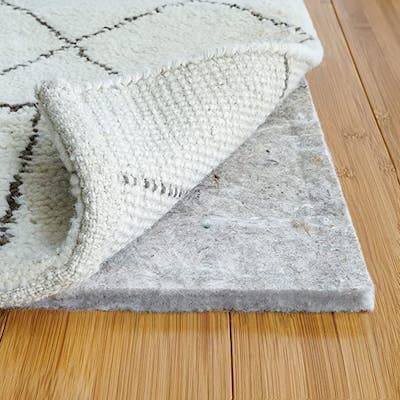 |
 |
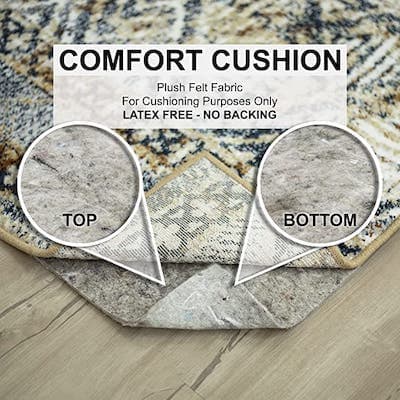 |
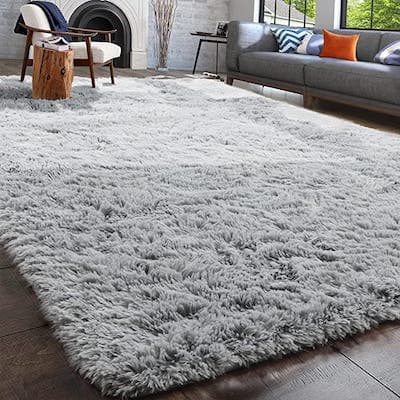 |
 |
|---|---|---|---|---|
| RUGPADUSA Cushioning Rug Pad | Peel & Stick Carpet Tiles (12 sf) | Mohawk Home Rug Pad | PAGISOFE Fluffy Area Rug | Faux Thick Realistic Grass Mats & Rugs |
| 4.5 18500+ ratings |
4.7 1100+ ratings |
4.5 12500+ ratings |
4.3 2000+ ratings |
4.5 1800+ ratings |
| $25 - $100 | $10 - $25 | $50 - $125 | $25 - $75 | $50 - $150 |

